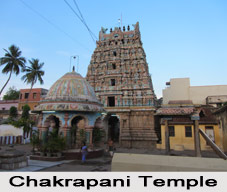 Sri Chakrapani Svami temple is famous for its antiquity and the legendary stories associated with it. The architectural skill of the contemporary craftsmen has attached an additional grandeur to the temple. The entire sanctum of Sri Chakrapani Svami is east-facing temple and it is the exceptional specimen of the contemporary architectural pieces. The temple enshrines in the main sanctum, the awe-inspiring, standing image of Lord Sri Chakrapani or Chakra raja with the third eye (trinetra) on His forehead and eight hands holding various weapons including the conch (sankha) and discus (chakra) within the six-pointed (shadkona) chakra. Next to the Lord is erected the beautiful and gracious image of Goddess Sudarsanavalli. The proper arrangement of the images of the deities is extremely fascinating. Inside the sanctum, to the left side of Sri Chakrapani is erected the icon of Brahma, and to His left, those of Surya, Sri Chakrapani, Kumbakonam Agni and Ahivbudhnya (Siva). The utsava-murti or the processional image in this sanctum resembles the main image with eight arms holding the same number of weapons. The images of the deities are at the same time testifying the architectural craftsmanship.
Sri Chakrapani Svami temple is famous for its antiquity and the legendary stories associated with it. The architectural skill of the contemporary craftsmen has attached an additional grandeur to the temple. The entire sanctum of Sri Chakrapani Svami is east-facing temple and it is the exceptional specimen of the contemporary architectural pieces. The temple enshrines in the main sanctum, the awe-inspiring, standing image of Lord Sri Chakrapani or Chakra raja with the third eye (trinetra) on His forehead and eight hands holding various weapons including the conch (sankha) and discus (chakra) within the six-pointed (shadkona) chakra. Next to the Lord is erected the beautiful and gracious image of Goddess Sudarsanavalli. The proper arrangement of the images of the deities is extremely fascinating. Inside the sanctum, to the left side of Sri Chakrapani is erected the icon of Brahma, and to His left, those of Surya, Sri Chakrapani, Kumbakonam Agni and Ahivbudhnya (Siva). The utsava-murti or the processional image in this sanctum resembles the main image with eight arms holding the same number of weapons. The images of the deities are at the same time testifying the architectural craftsmanship.
The structural design of the temple is no less fascinating. The excellence of the contemporary artists is evident from the structural design of the shrine. This principal sanctum is on a higher level than the rest of the temple and has to be ascended by a flight of steps. The vimana above the main sanctum is known as Vaidika Vimana, which is the evidence of the contemporary sculpture. Immediately in front of this sanctum is erected a small pillared mandapa where there is another bronze icon of Sudarsana and an alcove in front enshrines the image of Sri Garuda.
Another larger mandapa in front houses the rare and yet unusual metal sculpture of the Maratha king of Tanjavur, Sarabhoji Maharaja with his daughter by his side. With this architectural specimen, a legendary story is also associated. It is believed that this ruler`s daughter was suffering from an illness, which was cured through the grace of Sri Chakrapani. The king was elated and became the devotee of the lord. This devotee-king installed these bronze icons erected in the posture of prayerful attitudes facing Lord Chakrapani in gratitude. Moreover the king in addition made several benefactions to this temple. There are many deities like Lord Lakshmi Nrisimha, Sri Tumbikai Azhvar, Lord Lakshmi Narayana, Sri Anjaneya and Lord Vaikunthanatha are enshrined in tiny shrines in the circumambulatory passage (pradakshina patha) around the main sanctum.
In the outer prakara of this temple is a separate sanctum dedicated to Goddess Vijayavalli. It was constructed during the time of Sri Ahobila Math`s 41st Jiyar under the order of Shri Uttara Ahobila Mathadhipati Sarvatantra Svatantra Sriman Svami Bala Mukundacharya by his disciples. The entrance to the temple is highly attractive. The principal gate or the entrance is through a medium sized gopura next to which is located a round shaped mandapa carved in the Maratha style of architecture. The architectural style is possibly a product of king Sarabhoji`s era. A separate sannidhi enshrining the large image of Vira-Anjaneya and the sacred tank (pushkarini) called Chakra Tirtha is found nearby. Thus the architecture of the temple has attached an imposing splendor to the antique temple.





















